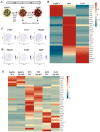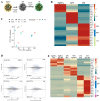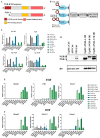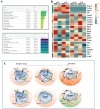Progesterone Receptor Modulates Extraembryonic Mesoderm and Cardiac Progenitor Specification during Mouse Gastrulation
- PMID: 36142249
- PMCID: PMC9499561
- DOI: 10.3390/ijms231810307
Progesterone Receptor Modulates Extraembryonic Mesoderm and Cardiac Progenitor Specification during Mouse Gastrulation
Abstract
Progesterone treatment is commonly employed to promote and support pregnancy. While maternal tissues are the main progesterone targets in humans and mice, its receptor (PGR) is expressed in the murine embryo, questioning its function during embryonic development. Progesterone has been previously associated with murine blastocyst development. Whether it contributes to lineage specification is largely unknown. Gastrulation initiates lineage specification and generation of the progenitors contributing to all organs. Cells passing through the primitive streak (PS) will give rise to the mesoderm and endoderm. Cells emerging posteriorly will form the extraembryonic mesodermal tissues supporting embryonic growth. Cells arising anteriorly will contribute to the embryonic heart in two sets of distinct progenitors, first (FHF) and second heart field (SHF). We found that PGR is expressed in a posterior-anterior gradient in the PS of gastrulating embryos. We established in vitro differentiation systems inducing posterior (extraembryonic) and anterior (cardiac) mesoderm to unravel PGR function. We discovered that PGR specifically modulates extraembryonic and cardiac mesoderm. Overexpression experiments revealed that PGR safeguards cardiac differentiation, blocking premature SHF progenitor specification and sustaining the FHF progenitor pool. This role of PGR in heart development indicates that progesterone administration should be closely monitored in potential early-pregnancy patients undergoing infertility treatment.
Keywords: ECM; cardiac differentiation; cell adhesion; epiblast stem cells; extraembryonic mesoderm; mesoderm induction; mouse gastrulation; progesterone receptor.
Conflict of interest statement
The authors declare no conflict of interest.
Figures








Similar articles
-
The allocation of epiblast cells to the embryonic heart and other mesodermal lineages: the role of ingression and tissue movement during gastrulation.Development. 1997 May;124(9):1631-42. doi: 10.1242/dev.124.9.1631. Development. 1997. PMID: 9165112
-
Regionalisation of cell fate and morphogenetic movement of the mesoderm during mouse gastrulation.Dev Genet. 1995;17(1):16-28. doi: 10.1002/dvg.1020170104. Dev Genet. 1995. PMID: 7554492
-
Mouse gastrulation: Coordination of tissue patterning, specification and diversification of cell fate.Mech Dev. 2020 Sep;163:103617. doi: 10.1016/j.mod.2020.103617. Epub 2020 May 27. Mech Dev. 2020. PMID: 32473204 Free PMC article. Review.
-
Murine cardiac progenitor cells require visceral embryonic endoderm and primitive streak for terminal differentiation.Dev Dyn. 1997 Nov;210(3):344-53. doi: 10.1002/(SICI)1097-0177(199711)210:3<344::AID-AJA13>3.0.CO;2-A. Dev Dyn. 1997. PMID: 9389458
-
The mouse fetal-placental arterial connection: A paradigm involving the primitive streak and visceral endoderm with implications for human development.Wiley Interdiscip Rev Dev Biol. 2020 Mar;9(2):e362. doi: 10.1002/wdev.362. Epub 2019 Oct 17. Wiley Interdiscip Rev Dev Biol. 2020. PMID: 31622045 Review.
Cited by
-
Whole-Genome Omics Elucidates the Role of CCM1 and Progesterone in Cerebral Cavernous Malformations within CmPn Networks.Diagnostics (Basel). 2024 Aug 28;14(17):1895. doi: 10.3390/diagnostics14171895. Diagnostics (Basel). 2024. PMID: 39272679 Free PMC article.
-
Cell-context response to germ layer differentiation signals is predetermined by the epigenome in regionalized epiblast populations.Nat Commun. 2025 May 29;16(1):5000. doi: 10.1038/s41467-025-60348-6. Nat Commun. 2025. PMID: 40442089 Free PMC article.
-
Derivation of Human Extraembryonic Mesoderm-like Cells from Primitive Endoderm.Int J Mol Sci. 2023 Jul 12;24(14):11366. doi: 10.3390/ijms241411366. Int J Mol Sci. 2023. PMID: 37511125 Free PMC article.
References
-
- Sim C.B., Phipson B., Ziemann M., Rafehi H., Mills R.J., Watt K.I., Abu-Bonsrah K.D., Kalathur R.K., Voges H.K., Dinh D.T., et al. Sex-Specific Control of Human Heart Maturation by the Progesterone Receptor. Circulation. 2021;143:1614–1628. doi: 10.1161/CIRCULATIONAHA.120.051921. - DOI - PMC - PubMed
MeSH terms
Substances
Grants and funding
LinkOut - more resources
Full Text Sources
Molecular Biology Databases
Research Materials

